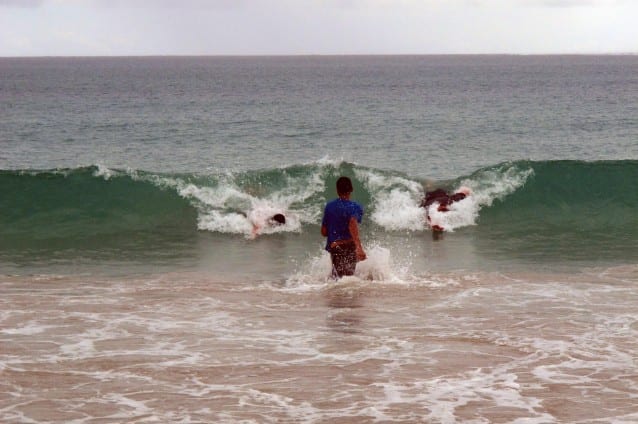As sea level rises, Fijian village begins to relocate citizens
Bodysurfers ride a wave at Natadola Beach in Natadola, Fiji, on Nov. 5, 2013.
Faced with rising sea levels that flood farmlands and seep into homes during high tide, residents of the Fijian village of Vunidogolo are packing their bags.
The village is the first to have its citizens relocated under the country’s “climate change refugee” program, according to a report in the Fiji Times. The relocation has included the construction of 30 houses, fish ponds, and farms, which reportedly cost the small island’s government about $879,000.
“All 30 houses have been fully constructed, painted and prepared well for the villagers,” Fiji Acting Commissioner Northern Alipate Bolalevu told the Times. “The Fisheries Department is in charge of the fish ponds and the Agriculture Ministry will help the villagers with farming practices.”
The village’s relocation is not the first instance where people have sought “refugee”-like status from the affects of climate change. Last year, 37-year-old Ioane Teitota and his family attempted to legally seek refugee status in New Zealand, having left Kiribati — a low-lying Pacific Island nation near the equator — in 2007 due to sea level rise. Though his request was eventually rejected, one of Teiota’s core arguments for refugee status was that humans cause exorbitant carbon emissions, which are responsible for rising sea levels and changes of weather patterns. Therefore, he argued, climate change constitutes an indirect but worldwide persecution on he and his family.
The New Zealand court called the argument “novel” and “optimistic,” but ultimately ruled that it was unconvincing. If it were adopted, the court said, then millions of people experiencing the effects of climate change could seek refuge in New Zealand or any other county.
Meanwhile, Fiji’s National Climate Change Policy says that it expects global sea level changes to more than double by the end of the century, based on projections from the fourth U.N. Intergovernmental Panel on Climate Change assessment report. The IPPC’s Fifth Assessment Report released in September, however, was even worse, predicting that ocean levels would rise by as much as three feet by the end of the century due to climate change.
The country’s 2012 policy document also notes that average monthly sea levels at the country’s Lautoka tide have been increasing at a rate of 4.6 millimeter per decade since 1993, though satellite observations indicate that the sea level is changing at the faster rate of 6 millimeters per year over the same period.
While Fiji is a minor emitter of greenhouse gases on a global scale, the country has nonetheless expressed a desire to commit to reducing its own emissions. However, the country’s climate policy document notes that Fiji faces “major barriers to improved energy efficiency,” most notably lack of information, inadequate pricing signals, and a lack of standards for imported appliances and machinery.
Rising sea levels in Fiji also stand to affect the country’s tourism industry. With the island receiving more than 500,000 visitors per year, the industry is the largest and fastest-growing, contributing about 17 percent to Fiji’s overall gross domestic product and employing approximately 40,000.


